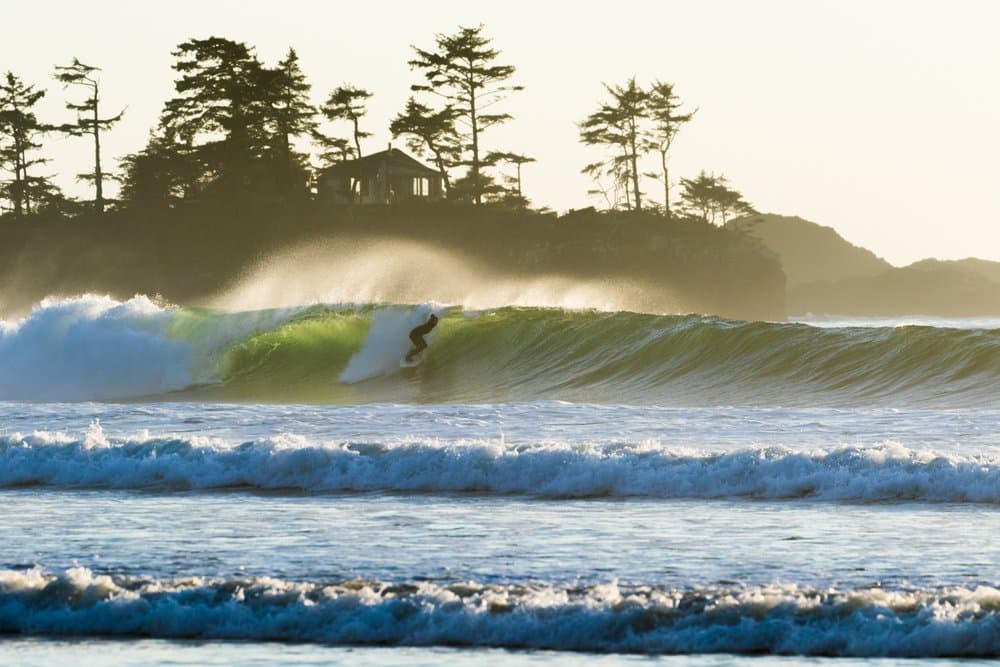Canada’s expansive coastline beckons surfers with its untamed beauty. As the popularity of surfing continues to rise along these pristine shores, the delicate balance between coastal recreation and conservation efforts comes into focus, raising questions about the impact on the landscape, marine biodiversity, and indigenous cultural heritage. Explore the intriguing challenge of preserving nature’s wonders while riding the perfect wave in Canada.
—
Canada’s breathtaking coastline stretches for over 202,000 kilometres, making it the longest coastline in the world. Nestled along Canada’s majestic coastlines, a captivating world of untamed beauty awaits. From the rugged cliffs of Newfoundland and Labrador to the temperate shores of British Columbia, this vast expense of shoreline is a testament to the country’s natural beauty and diversity.
The country’s pristine coasts have long been a source of wonder and inspiration, attracting adventurers and nature enthusiasts from all over the world. Among the many activities that draw people to Canada’s coasts, surfing has gained popularity in recent years, with thousands of adventures visiting the Canadian coastline to ride the perfect wave.
However, beneath the surface of this surfing paradise lies a delicate balance to be struck – one that weaves together the allure of coastal recreation with the urgent call for conservation efforts. Are surfers real beach warriors who embrace the beauty of the waves they seek to tame, or do they pose harm to marine biodiversity and indigenous cultural heritage?
The Allure of Canada’s Shores
The allure of Canada’s untamed coasts lies in their pristine beauty and unspoiled landscapes. From the remote stretches of British Columbia to the wild shores of Nova Scotia, the country’s coastlines are teeming with diverse ecosystems, wildlife, and unique geological formations. Protecting these fragile environments is paramount to preserving Canada’s natural heritage for future generations.
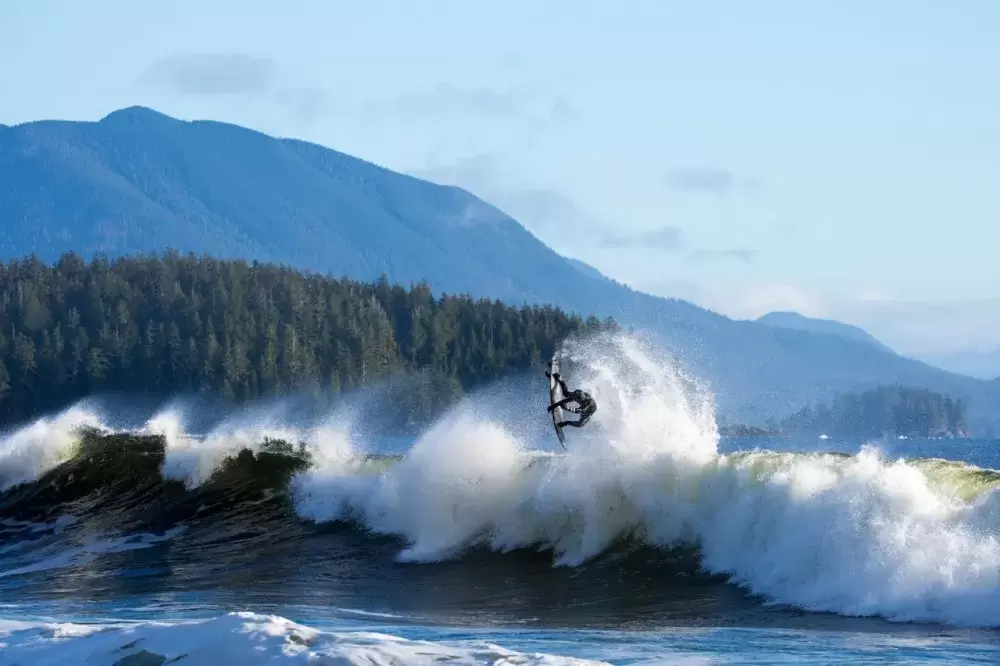
West Vancouver is a popular surf spot for adventure enthusiasts from around the world. Photo: James Martin.
Canada’s coasts are not just mere surf spots; they are thriving ecosystems teeming with life. The cold waters are home to a rich diversity of marine species, including seals, whales, and countless fish. Coastal habitats are essential for migratory birds, providing rest stops on their long journeys. And let’s not forget the importance of kelp forests and seagrass beds in absorbing carbon dioxide and maintaining healthy ocean ecosystems. These coastal areas are the lifeblood of our planet, and they deserve our utmost respect and protection.
Surfing, a sport rooted in harmony with nature, presents both an opportunity and a challenge in this conservation effort. As surfers paddle out into the waves and ride them to shore, they become intimately connected with the ocean and its surroundings. However, the rapid growth of the sport and its associated infrastructure, such as surf schools, rental shops, and beachfront developments, can have unintended consequences for the environment.
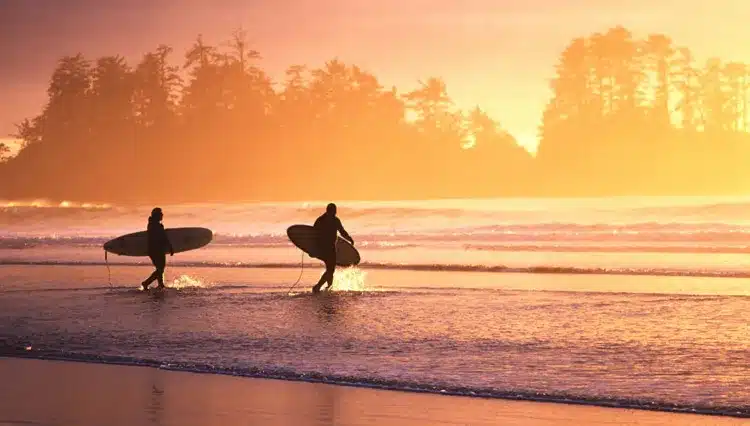
Canada’s coasts are not just mere surf spots; they are thriving ecosystems teeming with life. Photo: Adrian Dorst/Pinterest.
Surfing as an Ecological Conundrum
Surfing, like any recreational activity, has the potential to impact the environment. However, it is essential to recognise that surfers are not inherently destructive to coastal ecosystems. Instead, the way surfing is practiced, regulated, and the awareness of its ecological footprint determine whether it contributes positively or negatively to the environment.
One of the most glaring issues is the strain placed on local infrastructures. Many surf destinations lack the necessary facilities and resources to handle a sudden surge in visitors. This often leads to overcrowded lineups, increased waste, and inadequate waste disposal systems, resulting in the pollution of pristine coastal environments. In addition, the commodification of surf spots can drive up living costs for locals, pushing them out of their homes and eroding the authenticity of once-charming communities. As waves become overcrowded and competitive, tensions can flare among surfers and local communities, disrupting the peaceful harmony that the ocean has to offer.
Speaking to Patagonia, Australian surfer and activist Dave Rastovich and Southern Californian surfer Greg Long highlight that there can be a lot of negative repercussions from an influx of tourism of any kind if the area’s infrastructure is not set up to support it. In their opinion, a lot of places have changed to cater to the materialistic behaviours and desires of the fast-paced Westernised world. Taking Bali as an example, both activists agree that places with an incredible cultural and wave-rich environment are put under a lot of duress and pressure, often resulting in plastic pollution and loss of local culture.

Surfing, like any recreational activity, has the potential to impact the environment. Photo: Marcus Paladino/North Island College.
Surf Tourism’s Impact on Tofino, British Columbia
An example that reflects the two surfers’ concerns is Tofino, a coastal town in Canada’s British Columbia.
Tofino is renowned for its natural beauty, including pristine beaches and world-class surf breaks. Over the years, Tofino has become a popular destination for surfers and tourists from around the world, seeking to experience the rugged charm of Vancouver Island’s west coast. However, the rapid growth of surf tourism in Tofino has brought several challenges. The area’s infrastructure, originally designed to cater to a smaller local population, has struggled to cope with the influx of visitors. This led to issues such as traffic congestion, inadequate waste management, and overcrowding at popular surf breaks.
In addition, housing availability and affordability has become a critical issue for employers and employees alike. The cost of living is high; Tofitians pay on average 12% more for a bag of groceries than their neighbours in Port Alberni, a winding 90-minute drive east over rugged Sutton Pass on Highway 4. Indeed, the rise in real estate development, driven by the demand for vacation homes and accommodations, has also driven up housing costs, making it increasingly difficult for residents to afford to live in their own community. As a result, Tofino has faced concerns about gentrification and the potential loss of its unique cultural character.
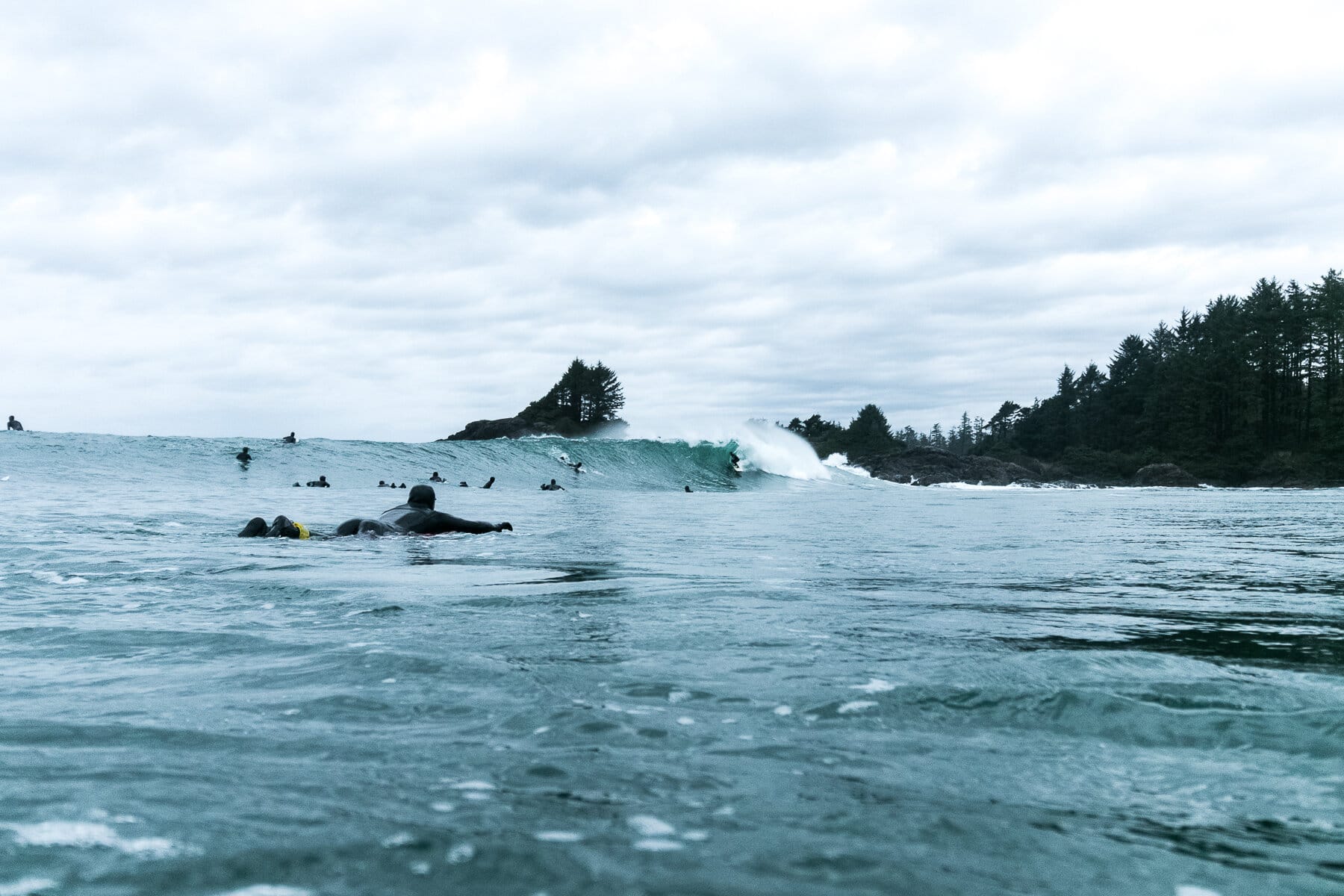
Coastal recreation is a way of life for many Canadians, providing opportunities for relaxation, exercise, and connection with nature. Credit: Tofino Surf Photography/Keenan Bush.
This is further reflected when in 2019 the Clayoquot Biosphere Trust and the District of Tofino joined forces to host the Vital Conversation on Sustainable Tourism. It brought stakeholders together from the business sector, First Nations, non-profit, and government sectors to talk about tourism. It was a testy conversation that revealed an angst about the impact of tourism, particularly regarding the demands for high-cost infrastructure, such as water, waste management, and roads. It reflected the residents’ sense of well-being and an overall concern about continued visitor growth at the expense of environmental integrity.
Surf Tourism and Indigenous Cultural Heritage
The surge in popularity of surf tourism has also impacted Indigenous cultural heritage, especially in the region of British Columbia. Many of the coastal areas in the province hold deep spiritual and historical significance for indigenous communities, often serving as sites of traditional ceremonies, storytelling, and connection to ancestral lands. The influx of surfers and tourists can disrupt these sacred spaces, potentially leading to the erosion of Indigenous cultural heritage. The noise, increased foot traffic, and changes in the natural environment can disrupt the tranquility and sanctity of these areas.
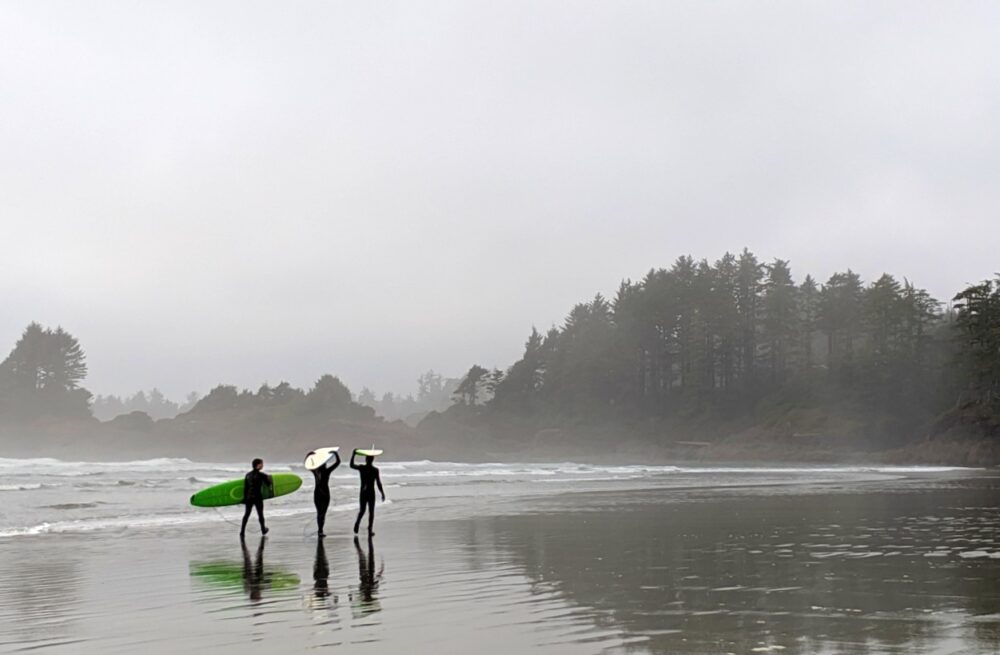
The surge in popularity of surf tourism has also impacted Indigenous cultural heritage, especially in the region of British Columbia. Photo: Off Track Travel.
Moreover, the commercialisation of surf tourism can sometimes overshadow the voices and rights of indigenous peoples, leading to a loss of control over their ancestral territories. An example of surf tourism’s impact on indigenous cultural heritage can be found in Tofino, which apart from its stunning coastal areas, is home to the Nuu-chah-nulth First Nations, who have inhabited these lands for thousands of years and maintain a profound connection to the ocean and its resources.
The noise generated by an increasing number of visitors, the bustling crowds descending upon these revered sites, and the relentless march of commercial development have all sounded alarm bells within the Nuu-chah-nulth community. These changes raise significant concerns about the disruption of these sacred places, which are the very heart of their cultural practices. There is a palpable fear that the influx of surfers and tourists may inadvertently erode the sacredness of these places, potentially altering the indigenous cultural practices that have thrived there for centuries.
You might also like: How to Live a More Sustainable Life in 2023
How Can Surfers and Coastal Enthusiasts Strike the Balance Between Pursuing Their Passion and Conserving Invaluable Ecosystems?
The answer lies in mindful, sustainable, and environmentally conscious practices.
First and foremost, surfers can become stewards of the environment. Every time they paddle out, they have a responsibility to minimise their impact on the coastal ecosystems they cherish. This starts with respecting local regulations, including protected areas and wildlife habitats. It means picking up trash, reducing plastic waste, and participating in beach cleanups. Surfers should also be aware of the fragile balance between human activity and nature and strive to leave no trace in their presence.
Indeed, surfers in Canada have already started acknowledging their impact and over the recent years, numerous initiatives and organisations have established programs that seek to protect the Canadian coastline. Surfrider Foundation Canada is a great example. The foundation, a branch of the US-based Surfrider Foundation, frequently organises beach cleanups around popular surf spots in British Columbia with much success. Most recently, its beach cleanup, which took place earlier this month, engaged surfers, university students, and children in removing waste from Victoria, British Columbia. This is a great example for other surfers to follow and become advocates for a cleaner, healthier coastal environment.
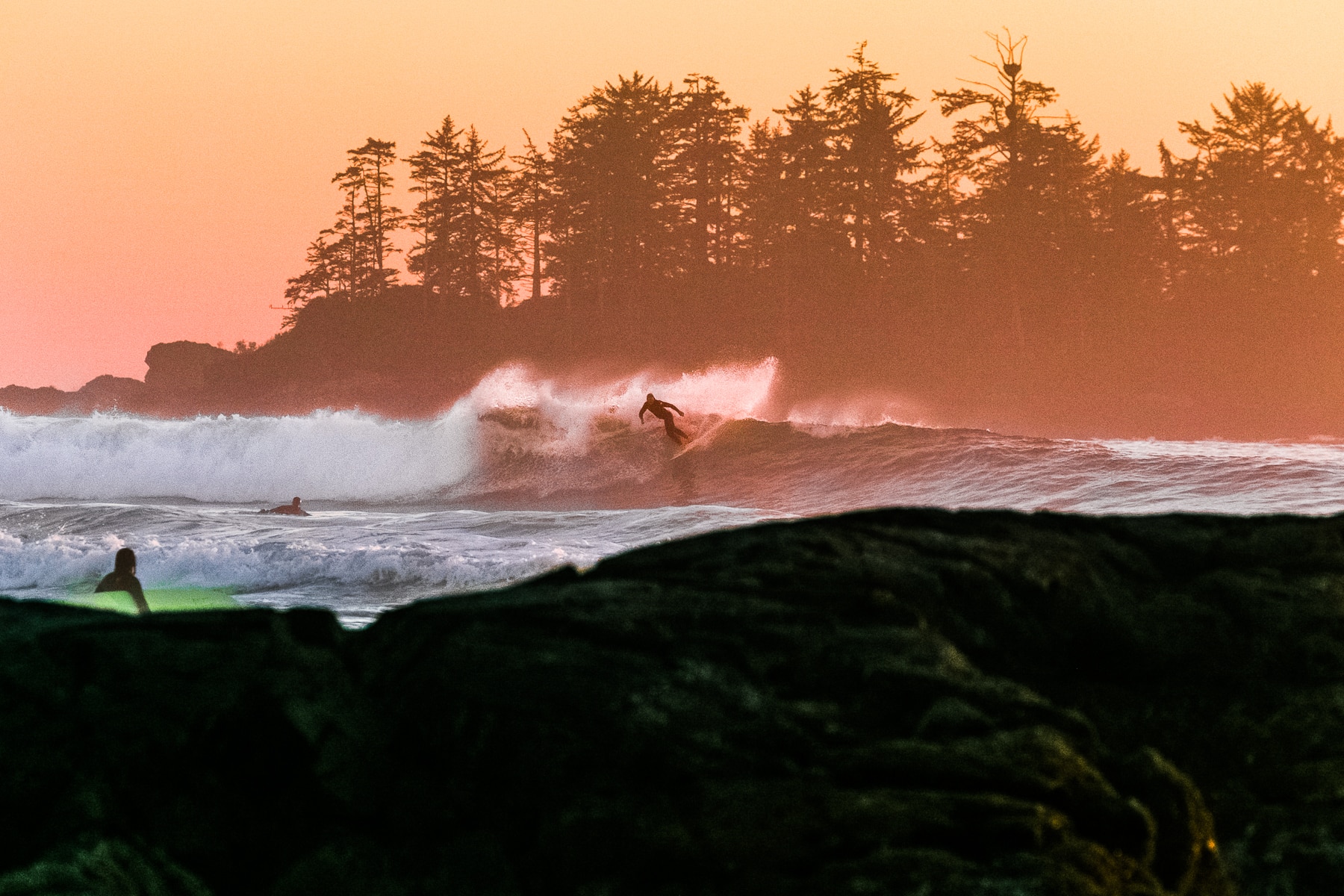
The answer to striking a balance between coastal recreation and conservation efforts lies in mindful, sustainable, and environmentally conscious practices. Photo: Tofino Surf Photography/Keenan Bush.
But let’s not stop at individual actions. The surfing community has tremendous potential to drive change and inspire others to follow suit. Surfers are uniquely positioned to raise awareness about coastal conservation issues. Through social media, documentaries, and community events, surfers can amplify the voices of scientists, conservationists, and indigenous communities who are advocating for the protection of the Canadian coastlines.
One inspiring example of this is the collaboration between surfers and several indigenous communities in Canada. By forging partnerships and listening to their wisdom, surfers can learn valuable lessons in conservation and sustainability.
Introducing the Mułaa Surf Team
Educational institutions, surfers, and organisations have started acknowledging the impact of the influx of surf tourism in spaces where indigenous cultural practices thrive. As a response, the Mułaa surf team, aptly translated to “Riding Tide” in the Tla-o-qui-aht language, was established in 2019 with the mission to employ surfing as a conduit for supporting local youth and reconnecting them with the great outdoors and the vast ocean that lies in their doorstep. The team’s foundation rests on pillars such as culture, language, and surfing.
In the heart of the unceded Tla-o-qui-aht territory near Tofino, British Columbia, Nuu-chah-nulth youth, instructors, and elders gather on the beach for a language lesson before embarking on surf lessons. These sessions offer an opportunity for these young individuals to acquire new skills while nurturing a profound connection to the island’s land and waters that their ancestors have called home for millennia.
This initiative aligns beautifully with the rich traditions of the Nuu-chah-nulth and other Indigenous Nations that have thrived along the coasts, islands, and beaches of Vancouver Island. It i a beautiful example of how surfing is not just a mere sport but can be a bridge to accessing traditional knowledge in a contemporary setting. What is more, the Mułaa initiative strives to address the importance of representation, recognising that Indigenous territory encompasses not only the land but also the water.
By fostering a supporting and inclusive environment, Mułaa allows these youth to see themselves represented in the waves, building their comfort and confidence in the ocean while honouring their cultural heritage. Amidst the laughter and camaraderie of surfers and bobbing surfboards, the Mułaa programme empowers youth to carve out a space for themselves, nurturing new skills, and forging a deeper connection to the islands’ lands and water that have been an integral part of their heritage for generations.
Finding a Balance Between Coastal Recreation and Conservation Efforts
The key to successful conservation efforts lies in finding common ground. Surfing, like many outdoor activities, is a source of joy, inspiration, and solace for countless individuals. It provides an opportunity to connect with the ocean on a profound level. By emphasising the connection between surfing and conservation, we can rally surfers to become true environmental champions.
Imagine a world where surfers are not only riding waves but also advocating for cleaner oceans, supporting marine protected areas, and engaging in scientific research to better understand coastal ecosystems.
This vision is not far-fetched, as evidenced by the work done by Surfrider Foundation Canada and the Mułaa program. As these examples depict, balancing surfing and conservation is achievable through collective action and a shared commitment to preserving the natural heritage of Canada.

The journey of balancing conservation and coastal recreation is not an easy one, but it’s a noble and necessary endeavour. Photo: Surfline Canada.
Surfers are drawn to the ocean’s beauty and power. It is a magnetic force that pulls them to the shore, where they paddle out with salt in their hair and the horizon stretching endlessly before them. But this pull is not just about the pursuit of their own pleasure; it’s about connecting with something greater than themselves. It’s about recognising the responsibility they hold to protect the ocean and its surrounding ecosystems.
The journey of balancing conservation and coastal recreation is not an easy one, but it’s a noble and necessary endeavour. It requires surfers and coastal enthusiasts to be advocates, educators, and protectors of the very places that fuel their passion. It demands that they see themselves as custodians of the coast, working together to ensure that future generations can experience the same awe-inspiring moments they cherish today.
Surfing Canada’s untamed coasts can be a symbol of hope and change. It can be a shining example of how humans can coexist with nature. It’s a challenge, an adventure, and a call to action. Together, surfers, local communities and local initiatives can ride the waves of change and inspire a future where conservation and coastal recreation thrive side by side. Surfers have already started working hard to build a harmonious relationship with the coastline they love so dearly, and this is a positive sign that the future of Canada’s wild coastlines can be indeed a positive one.
Featured image: Tofino Surf Photography/Keenan Bush.
You might also like: 5 Pressing Environmental Issues in Canada in 2023








